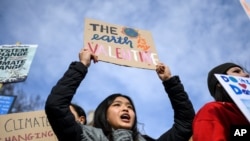UNICEF Executive Director Henrietta Fore says a new UNICEF report gives for the first time “a complete picture of where and how children are vulnerable to climate change.” She adds in her statement that the “picture is almost unimaginably dire.”
The Climate Crisis Is a Child Rights Crisis: Introducing the Children’s Climate Risk Index, published Friday, is “the first comprehensive analysis of climate risk from a child’s perspective,” according to the U.N.’s children's agency. In the report, countries are ranked on children’s exposure to climate and environmental hazards.
The report says about half of the world’s nearly 2.2 billion children live in one of the countries identified as “extremely high-risk" where they also are facing “a high vulnerability due to inadequate essential services, such as water and sanitation, healthcare and education.”
The risk index includes children’s exposure to coastal flooding, riverine flooding, cyclones, vector-borne diseases, lead pollution, heatwaves, water scarcity and “exceedingly high levels of air pollution.” Children living in the Central African Republic, Chad, Nigeria, Guinea, and Guinea-Bissau are the young people most at risk, according to the report.
To reverse the risks children are facing, UNICEF is calling on the world’s governments to increase investment in climate adaptation and resilience in key services for children, including water, sanitation and hygiene systems, health and education services and to reduce greenhouse gas emissions.
The U.N. agency also is urging governments to provide children with climate education and the skills needed to develop and maintain a resource-efficient society, which UNICEF says are “critical” for the children’s “adaptation to and preparation for the effects of climate change.
The agency would also like to see young people included in all national, regional and international climate negotiations and decisions.
The agency also addressed children’s needs after the COVID pandemic, calling for a recovery that is “green, low-carbon and inclusive, so that the capacity of future generations to address and respond to the climate crisis is not compromised.”
The report says an estimated 850 million children reside in regions where they are facing at least four overlapping hazards, while at least 330 million face at least five of the hazards.
“But there is still time to act. Improving children’s access to essential services, such as water and sanitation, health, and education, can significantly increase their ability to survive these climate hazards,” Fore said.









